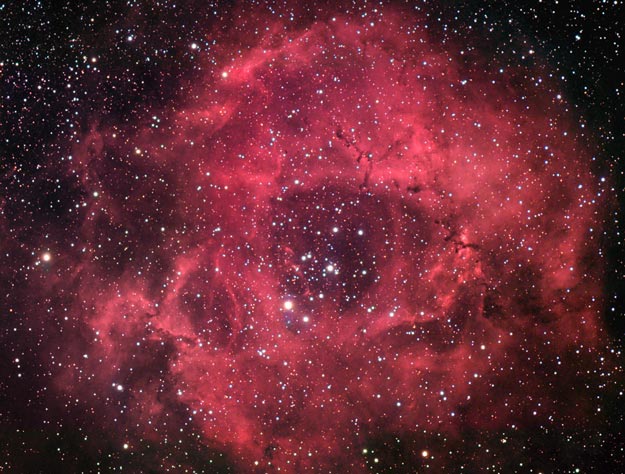Astronomy Picture of the Day
Discover the cosmos! Each day a different image or photograph of our fascinating universe is featured, along with a brief explanation written by a professional astronomer.
Posted on 02/28/2003 5:26:33 AM PST by petuniasevan
Discover the cosmos! Each day a different image or photograph of our fascinating universe is featured, along with a brief explanation written by a professional astronomer.
Explanation: Glowing hydrogen gas fills this gorgeously detailed sky view centered on the variable star S Mon in the faint but fanciful constellation Monoceros, the Unicorn. A star forming region (NGC 2264), the complex jumble of cosmic gas and dust clouds is about 2,700 light-years distant and mixes reddish emission nebulae excited by energetic light from newborn stars with dark interstellar dust clouds. Where the otherwise obscuring dust clouds lie close to stars they also reflect starlight, forming blue reflection nebulae. The wide vista spans about 1.5 degrees or nearly 3 full moons, covering 70 light-years at the distance of NGC 2264. Its cast of cosmic characters includes the Cone Nebula (far left), the Fox Fur Nebula, whose convoluted pelt lies just below S Mon, and the Christmas Tree star cluster. The triangular Christmas Tree cluster appears sideways here, with its apex at the Cone Nebula and its broader base centered on S Mon.
This area is found in northern Monoceros (Unicorn).
It is just a little bit east-northeast of Orion's bright orange star Betelgeuse.
Here is a chart of the region. The above image is designated NGC 2264.

Did you notice on the chart that there was an object (just a little below NGC 2264) called NGC 2244? That designates the Rosette Nebula. It's another star-forming region, and a favorite of astrophotographers.


"The stardust grains we discovered are typical of the kinds of dust that were available at the beginning of our solar system, these were the building blocks of the sun and planets," said Dr. Lindsay Keller, an author of the paper and a researcher in the Office of Astromaterials Research and Exploration Science at NASA's Johnson Space Center, Houston. "Comet samples are the logical place to look for preserved stardust. They formed in a region of the solar system where they escaped the extensive processing that affected other solar system materials," he said. Before the sun formed, our solar system was a swirling cloud of dust and gas, the remnants of dead stars from other parts of the galaxy. Some of this dust survived the formation of the solar system unchanged to end up in comets. These comets contain the ingredients of the early solar system, the ingredients for which came from the remnants of early stars in the universe.
"The fact that these IDPs are rich in stardust and molecular cloud material suggests that they have remained essentially unchanged from the time the solar system formed, 4.5 billion years ago," said Dr. Scott Messenger, lead author of the paper and an astrophysicist at Washington University in St. Louis.
The discovery was made possible by using a new kind of ion microprobe at Washington University, which measures isotopic ratios on scales much smaller than previously possible. This is essential for identifying stardust grains, because, "they have isotopic ratios very different from anything in the solar system," Messenger said. Most collected IDPs range in size from 5 to 50 millionths of a meter, and often contain crystalline grains clumped together in sizes of 100 to 500 billionths of a meter.
Disclaimer: Opinions posted on Free Republic are those of the individual posters and do not necessarily represent the opinion of Free Republic or its management. All materials posted herein are protected by copyright law and the exemption for fair use of copyrighted works.